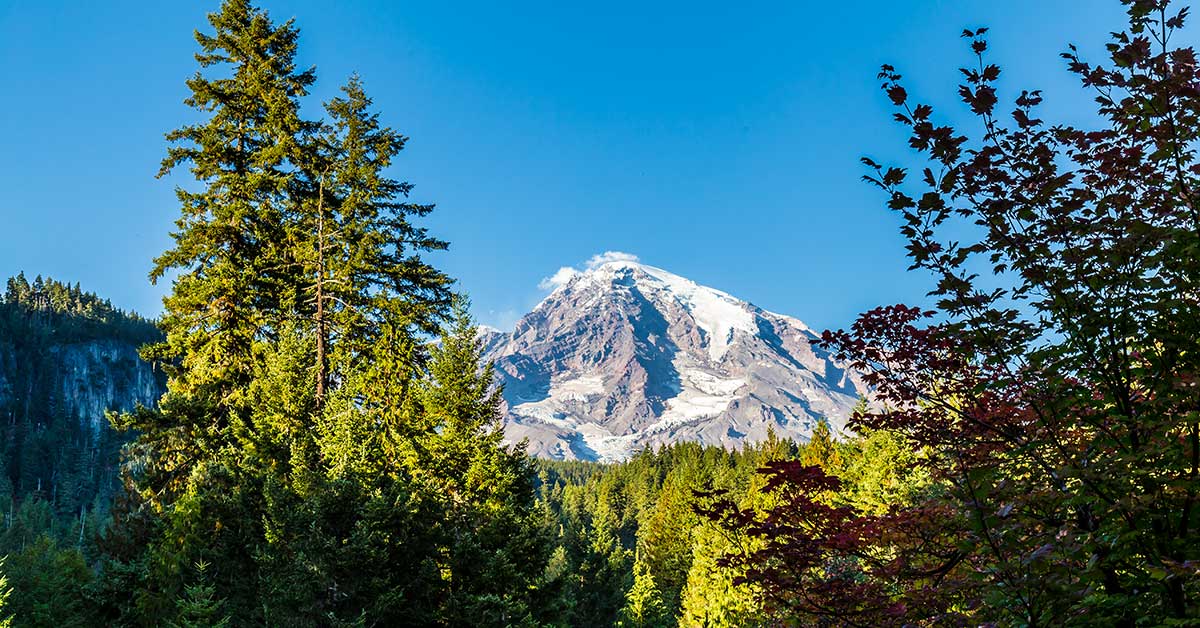As the highest peak in Washington State, Mount Rainier is a slumbering behemoth that last erupted in the 1890s. It is a large stratovolcano in the Cascade Range of the Pacific Northwest that has actually erupted thousands of times in its relatively young life.
 It has three major peaks: Liberty Cap, Point Success, and the summit of Columbia Credit. Noted for its dense expanse of coniferous trees on the lower slopes and scenic alpine meadows, during the warmer months of July and August, wildflowers abound, give the area new life with a kaleidoscope of colors.
It has three major peaks: Liberty Cap, Point Success, and the summit of Columbia Credit. Noted for its dense expanse of coniferous trees on the lower slopes and scenic alpine meadows, during the warmer months of July and August, wildflowers abound, give the area new life with a kaleidoscope of colors.
 Despite its mountainous topography, the national park has several points of entry from the surrounding lowlands, allowing easy access for visitors. Sunrise Visitor Center is a good starting point, as it has much information on the park and is stocked well with maps and books, as well as panoramic views of the mountain and Emmons Glacier. It is also a jumping-off point for numerous trails around the perimeter of Mount Rainier.
Despite its mountainous topography, the national park has several points of entry from the surrounding lowlands, allowing easy access for visitors. Sunrise Visitor Center is a good starting point, as it has much information on the park and is stocked well with maps and books, as well as panoramic views of the mountain and Emmons Glacier. It is also a jumping-off point for numerous trails around the perimeter of Mount Rainier.

Alternatively, Paradise Jackson Visitor Center offers exhibits, ranger programs, and films. Indeed, the little town of Paradise itself is a wonderful home base with which to explore the entire area. In the southeast corner of the park is the Ohanapecosh Visitor Center, nestled among thick old-growth forest and offering a stark contrast to the park's higher altitudes. Here the trees can be up to 300 feet tall and 1,000 years old.

Mowich Lake, the park's largest body of water, is the best place for kayaking, canoeing, camping, and many other outdoor activities.
A Bit of Mountain and Park History
Geologically, Mount Rainier is young; formed by a series of lava flows from eruptions starting about one million years ago. It is surrounded by the largest single-mountain glacial system in the U.S. outside of Alaska.
For millennia, the ancestors of modern indigenous people came to the mountain to hunt and gather resources. Today, those tribes strive to continue their deep connection to Mount Rainier. Then, in 1792, early European visitors were captivated by the mountain during their surveying of the Pacific coast. Captain George Vancouver of the British Royal Navy decided to name the mountain after his friend, Rear Admiral Peter Rainier.
It is also one of the nation's oldest parks, which became part of the federal system in 1899, shortly after the last eruption. Its park status was the result of a long campaign by John Muir and his fellow conservationists to preserve this unique forest, field, and glacial landscape under threat from timber and mining extraction that had already adversely affected a good portion of the American West.
Development of the park grew at a torrid and chaotic pace, with the largest balloon in visitation from 1906-1915. During this time, the advent of automobiles made the park more accessible, but this brought its own set of challenges. In fact, it was the first national park to allow cars, and park staff struggled with traffic control. Despite this, all roads that exist today in the park were built by 1930, as well as the majority of the park's infrastructure.
In 1988, the Washington Wilderness Act designated 98% of the park as wilderness, giving the lands greater protection from development.
Click here to see the Mount Rainier National Park poster.
Rob Decker is a photographer and graphic artist with a single passion for our National Parks! Rob is on a journey to explore and photograph each of our national parks and to create WPA-style posters to celebrate the amazing landscapes, vibrant culture and rich history that embody America's Best Idea!
Click here to learn about the Best Things To Do at Mount Rainier National Park.
Source: https://national-park-posters.com/blogs/national-park-posters/mount-rainier-a-young-giant

